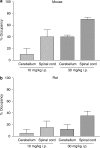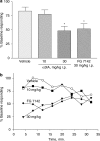Anxiogenic properties of an inverse agonist selective for alpha3 subunit-containing GABA A receptors
- PMID: 15655523
- PMCID: PMC1576012
- DOI: 10.1038/sj.bjp.0706056
Anxiogenic properties of an inverse agonist selective for alpha3 subunit-containing GABA A receptors
Abstract
Alpha3IA (6-(4-pyridyl)-5-(4-methoxyphenyl)-3-carbomethoxy-1-methyl-1H-pyridin-2-one) is a pyridone with higher binding and functional affinity and greater inverse agonist efficacy for GABA(A) receptors containing an alpha3 rather than an alpha1, alpha2 or alpha5 subunit. If doses are selected that minimise the occupancy at these latter subtypes, then the in vivo effects of alpha3IA are most probably mediated by the alpha3 subtype. Alpha3IA has good CNS penetration in rats and mice as measured using a [(3)H]Ro 15-1788 in vivo binding assay. At doses in rats that produce relatively low levels of occupancy (12%) in the cerebellum (i.e. alpha1-containing receptors), alpha3IA (30 mg kg(-1) i.p.), like the nonselective partial inverse agonist N-methyl-beta-carboline-3-carboxamide (FG 7142), not only caused behavioural disruption in an operant, chain-pulling assay but was also anxiogenic in the elevated plus maze, an anxiogenic-like effect that could be blocked with the benzodiazepine antagonist Ro 15-1788 (flumazenil). Neurochemically, alpha3IA (30 mg kg(-1) i.p.) as well as FG 7142 (15 mg kg(-1) i.p.) increased the concentration of the dopamine metabolite 3,4-dihydroxyphenylacetic acid in rat medial prefrontal cortex by 74 and 68%, respectively, relative to vehicle-treated animals, a response that mimicked that seen following immobilisation stress. Taken together, these data demonstrate that an inverse agonist selective for GABA(A) receptors containing an alpha3 subunit is anxiogenic, and suggest that since alpha3-containing GABA(A) receptors play a role in anxiety, then agonists selective for this subtype should be anxiolytic.
Figures







References
-
- ATACK J.R., SMITH A.J., EMMS F., MCKERNAN R.M. Regional differences in the inhibition of mouse in vivo [3H]Ro 15-1788 binding reflect selectivity for α1 versusα2 and α3 subunit-containing GABAA receptors. Neuropharmacology. 1999;20:255–262. - PubMed
-
- BAYLEY P.J., BENTLEY G.D., JACKSON A., WILLIAMSON D., DAWSON G.R. Comparison of benzodiazepine (BZ) receptor agonists in two rodent activity tests. J. Psychopharmacol. 1996;10:206–213. - PubMed
-
- CASULA M.A., BROMIDGE F.A., PILLAI G.V., WINGROVE P.B., MARTIN K., MAUBACH K., SEABROOK G.R., WHITING P.J., HADINGHAM K.L. Identification of amino acid residues responsible for the α5 subunit binding selectivity of L-655,708, a benzodiazepine binding site ligand at the GABAA receptor. J. Neurochem. 2001;77:445–451. - PubMed
-
- CHAMBERS M.S., ATACK J.R., BROMIDGE F.A., BROUGHTON H.B., COOK S., DAWSON G.R., HOBBS S.C., MAUBACH K.A., REEVE A.J., SEABROOK G.R., WAFFORD K., MACLEOD A.M. 6,7-Dihydro-2-benzothiophen-4(5H)-ones: a novel class of GABA-A α5 receptor inverse agonists. J. Med. Chem. 2002;45:1176–1179. - PubMed
MeSH terms
Substances
LinkOut - more resources
Full Text Sources
Medical
Research Materials

